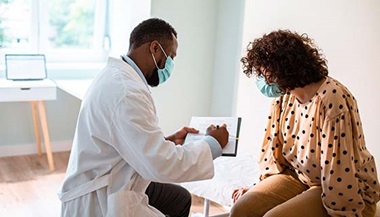Amplified Musculoskeletal Pain Syndrome in Children
Treatment for children who experience persistent pain, which may be affecting the whole body or just one area of the body.
Amplified musculoskeletal pain syndrome (AMPS) is a condition that can cause intense persistent or intermittent pain anywhere in the body. When a child has AMPS, he or she often experiences a degree of pain more intense than normally expected.
Children may develop AMPS after an injury, illness, or psychological stress. In the case of illness, it is more commonly seen in children with inflammatory conditions like arthritis or tendonitis, or diseases like mononucleosis (also known as mono) or influenza, though not all children with these health conditions will develop AMPS.
When we typically feel pain, it’s because our bodies are trying to alert us to an injury by sending a signal to our brains. With AMPS, pain perception is increased due to abnormal firing of nerves that sense pain.
AMPS also sends a signal to the nerves in the body that control blood flow (“fight or flight” nerves) and constricts the flow of blood through the blood vessels. This causes less oxygen to reach the muscles and bones and causes a buildup of waste products in the body like lactic acid, which contributes to the amplified pain we see with AMPS. It is important to understand that your child’s pain is real and can get better.
Forms of amplified pain
- Diffuse amplified pain, also called widespread body pain or juvenile fibromyalgia
- Intermittent amplified pain
- Complex regional pain syndrome (CRPS) with autonomic changes (autonomic changes include color and temperature changes – for example, cold and blue – as well as swelling and sweating) (CRPS) with autonomic changes (autonomic changes include color and temperature changes – for example, cold and blue – as well as swelling and sweating)
- Localized amplified pain without autonomic changes
Symptoms
Patients with AMPS have chronic musculoskeletal pain and may experience changes in color or temperature changes, swelling, or sweating in certain areas of the body (either in one spot or all over). AMPS is most often seen in pre-adolescent or adolescent girls.
Other signs and symptoms can include:
- Headache, abdominal pain, dizziness, joint pain or fast heart rate
- Increased sensitivity, with normal contact of the skin feeling especially painful
- Decreased mobility or use of the affected area of the body
- Fatigue or trouble sleeping
- Anxiety, depression or related concerns
Treatment
Successful treatment of AMPS can be challenging and requires focusing on physical functioning and pushing through discomfort to retrain the over-firing nerves and blood vessels. Treatment for AMPS includes:
Daily exercise guided by a physical therapist.
It is important for your child to complete daily exercises even when experiencing pain, soreness, or discomfort in affected areas. The physical therapist will assist in creating a plan for regular aerobic exercise to improve blood flow, circulatory symptoms, and physical function (including strength, endurance, conditioning, balance and flexibility). Your child may also need to be seen by an occupational therapist to decrease nerve sensitivity (also called desensitization) in the affected limb so that normal contact with the skin feels less and less painful.
Learning skills to manage the body’s stress response.
Stress can be a trigger for amplified pain and also a response to dealing with pain each day. Stressors can be positive or negative, big or small, and can include not just events, but feelings and personality styles.
Many patients with AMPS and their families have had negative or stressful experiences with peers, school officials, and health care professionals who have not believed their symptoms. Chronic pain does not only affect the child, but can have an impact on the whole family and family-child dynamics.
Children with AMPS and their families can benefit from various forms of psychotherapy such as cognitive-behavior therapy (CBT) or acceptance and commitment therapy (ACT), which can help teach coping strategies to manage pain, identify and cope with stressors, and adjust to changes that have occurred with AMPS and returning to regular activities while in pain.
Psychology is part of the pain team to assist in learning these skills, teach relaxation techniques to calm the body’s stress response (such diaphragmatic breathing, imagery, or progressive muscle relaxation), and promote incorporating coping skills (for example, journaling, creative writing, art, music, etc.) in everyday life. Psychology also focuses on using these skills to reduce the fear of AMPS pain and addressing common issues seen in youth with chronic pain such as anxiety or depression.
Decreasing attention to pain.
The more we focus on pain, the more we experience pain. While distraction is often a helpful way to shift attention, focusing on returning to normal activities is an effective long-term solution for AMPS. Focus on return to school, physical activity, spending times with friends and family, and extracurricular activities also helps teach the brain that pain is not dangerous. Return to normal activities can also allow patients to obtain more social support and continue to move forward with their values and goals. Focus on helping keep daily activity consistent, even when they are experiencing pain or discomfort.
It is important to address all of these areas to break the pain cycle. Pain and symptoms of AMPS often worsen before getting better and the ability to do normal activities returns before pain resolves. Youth who have continued pain have often not addressed each treatment area. It is important for families to know that children can return to their regular activities and become symptom-free.





